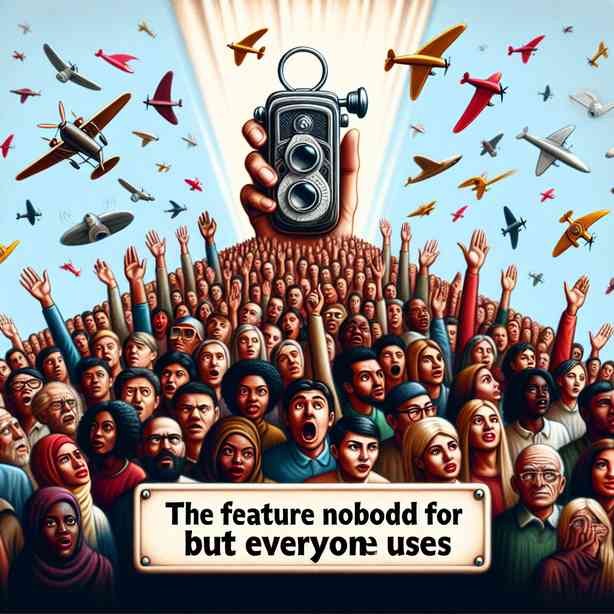
In the constantly evolving landscape of technology and digital services, there are features that become essential to users, often unexpectedly. These features, though they may not have been explicitly requested, find their way into our daily routines and enhance our experiences in unforeseen ways. One perfect example is the “dark mode” feature that most smartphones and applications have now adopted. Initially overlooked, this feature has gained immense popularity among users for its aesthetic appeal and practical benefits.
Dark mode was often developed in response to user complaints about eye strain and battery life, yet it wasn’t necessarily on many users’ radar as a must-have feature. However, once options for dark mode became available, feedback rapidly turned positive. Many users found that using dark mode in low-light environments significantly reduced eye fatigue and made the overall device experience more comfortable. Furthermore, for mobile users, especially those with OLED screens, dark mode offers a practical advantage by reducing battery consumption.
This unexpected embrace of dark mode reflects a larger trend in tech: features that are developed based on user experience but don’t tend to top the list of user-requested improvements. And while for some it might just be a matter of personal preference in visual aesthetics, for others it signifies well-being and improved usability.
Similarly, another feature that many might not have asked for initially but has become ubiquitous is the “auto-save” function. This has transitioned from being more of a novelty to an absolute necessity across various applications, ranging from document editors to design software. The anxiety often associated with losing progress is a shared experience among users; auto-save functions alleviate that fear, allowing for a seamless workflow.
Interestingly, the inception of auto-save emerged from recognizing user behavior patterns. Developers noticed that users frequently closed applications prematurely, often resulting in lost data. As a solution, they integrated the auto-save feature, initially met with skepticism from a few users who preferred manual saves. However, over time, the benefits became increasingly evident. These automatic progress checks foster a sense of security and encourage creativity as users feel less pressure while engaging in tasks that may require extended periods of focus.
Moreover, the effectiveness of an auto-save feature extends beyond simple document processing. Its presence in email applications and cloud services ensures that users can access their work anytime, anywhere, without fear of technical disruptions. Hence, what once seemed like an unnecessary addition has become an integral part of our digital experience, representing the evolution of user needs and technology solutions.
Furthermore, let’s consider the integration of “voice search” technology. This feature often arrived at the forefront without explicit user demands from everyone. However, its adoption has skyrocketed due to the confluence of convenience and accessibility it offers. In the era of busy lifestyles, voice search provides a way for users to multitask efficiently.
As people juggle between responsibilities, whether commuting, cooking, or exercising, they often seek methods that allow them to retrieve information without the need for their hands. Voice search technology caters precisely to this need. Users can quickly query information, control their devices, or send messages just by speaking a command. This feature was initially met with curiosity but has since become an everyday tool, reflecting how technology adapts to user habits and lifestyles in dynamic ways.
The trajectory of voice search technology underscores an essential facet of evolving digital services: the intersection of user lifestyle changes with technological innovation often leads to the creation of features that may not have been directly requested. Even though users may not have articulated the need for voice search initially, they later embraced it wholeheartedly, reshaping how we interact with our devices.
Discussing the unexpected yet popularly utilized features, let’s touch upon user privacy settings, particularly on social media platforms. While many users may not have explicitly asked for complex privacy options, a growing awareness about data security has reignited interest in fine-tuning these settings.
Social media platforms responded to various incidents regarding data breaches and privacy concerns by implementing more robust privacy controls. Users were able to customize who sees their content, manage their data collection preferences, and opt in or out of targeted advertising. Initially, many users might have found these settings cumbersome, yet as the understanding of data privacy grew, they realized the control these features offered over their digital footprints.
The gradual integration of enhanced privacy features highlights how times change, and user perception shifts. What was once considered an overwhelming and unnecessary complication now surfaces as a cornerstone for fostering trust and confidence in digital platforms. The users who once remained passive consumers of these platforms have actively engaged with privacy tools, demonstrating the significance of privacy in the digital age.
As we examine the landscape of features that no one explicitly asked for but have become valuable assets, it’s fascinating to observe how their seamless integration into our daily routines has happened. While these features often manifest in response to emerging user needs and behaviors, they reflect a deeper trend where technology ultimately serves to enhance the human experience.
In conclusion, features like dark mode, auto-save functions, voice search technology, and enhanced privacy settings exist within our digital environment thanks to the industry’s attentive and adaptive nature. They showcase how innovations emerge not just from voiced user demands but from carefully analyzing patterns and experiences. As users, acknowledging the impact of these features on our daily lives reinforces the essence of technology: it seeks to make our lives easier, more enjoyable, and aligned with our needs, often exceeding our expectations.
As technology continues to evolve, it is likely that we will see more such features that enhance our experiences in ways we may have never considered but soon come to rely upon.


